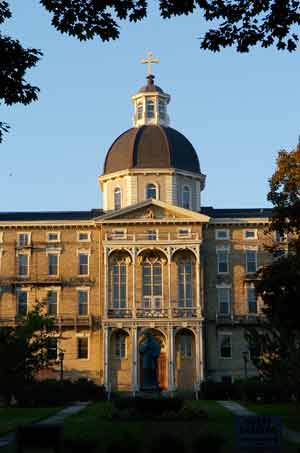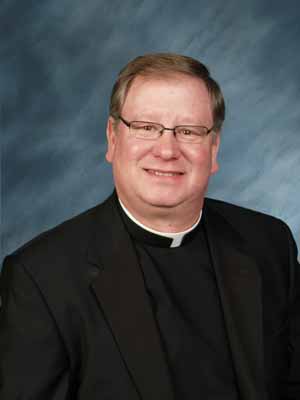A week after his appointment as the 19th rector of Saint Francis de Sales Seminary was announced, Fr. John Hemsing had not moved into the office of the rector, a space still  Catholic Herald file photo of Saint Francis de Sales Seminary, St. Francis, by Sam Lucero.occupied by his immediate predecessor, Bishop Donald J. Hying. What he will bring to that physical space in terms of books and effects may not be as telling as what he is bringing to the position itself on Oct. 1.
Catholic Herald file photo of Saint Francis de Sales Seminary, St. Francis, by Sam Lucero.occupied by his immediate predecessor, Bishop Donald J. Hying. What he will bring to that physical space in terms of books and effects may not be as telling as what he is bringing to the position itself on Oct. 1.
“I don’t come into this position with preconceived notions or any agenda save that of serving the Lord and the church,” the priest told your Catholic Herald Sept. 8.
In addition to the “support and confidence” of Archbishop Jerome E. Listecki, who asked him in June to consider taking the rectorship, Fr. Hemsing is bringing what he considers “gifts” to the office.
“My belief in Jesus Christ, his church and a love for God’s people. And the joy I have in being a priest,” he said. “I’m a happy guy. I enjoy being a priest. People often comment to me that as I celebrate Mass I smile; I don’t even realize I’m doing it because that’s the great joy I feel in my heart in the celebration of the Eucharist.”
A native of Sheboygan, where his home parish was St. Peter Claver, Fr. Hemsing, 49, is the youngest of Jerome and Mary Jane Hemsing’s four children. He has two brothers and a sister.
The priest is familiar with seminary education in the Archdiocese of Milwaukee. He entered De Sales Preparatory Seminary as a high school freshman in fall 1976. When that institution closed in 1979, he completed his senior year in the archdiocese’s Call to Ministry program. He entered Saint Francis de Sales College, only to have that close after two years. He completed his studies at Marquette University in the college seminary program in 1984. Four years later, he earned his master of divinity degree from Saint Francis de Sales Seminary, and was ordained a priest.
“It’s the one program that didn’t close while I was there,” Fr. Hemsing joked. In 1995, he was awarded a doctor of ministry degree in applied ministry from the Graduate Theological Foundation in South Bend, Ind.
While he has been associated with the seminary in a variety of ways, e.g., serving on the continuing formation of clergy board and as an interviewer for board of admissions, he “never thought I’d be rector of the seminary.”
“I always thought I’d be serving God’s people in a parish setting,” he said. “In fact, isn’t that what you want? You want someone who is helping form these men to be parish priests. Most of them, if not all of them at one point, are going to be serving in a parish. They’re not going to be academicians, they’re not going to be great theologians; they’re going to be general practitioners of the Catholic faith, passing on the faith to other
people.”
While the seminary has changed in the years since Fr. Hemsing was a student there, most notably the move of seminarians’ academic formation to the Sacred Heart School of Theology, Franklin, in 2006, it remains a house of formation in the human, spiritual and pastoral dimensions.
“The pastoral formation involves being able to put what one believes, what one has studied, into practice – to truly live as Christ lived because the priest stands in the person of Christ  Fr. John Hemsingwithin the faith community and within the world,” he said. “When one is ordained, the bishop says, ‘Believe what you read, teach what you believe and practice what you teach.’ Those are things you have to instill in those who are being formed.”
Fr. John Hemsingwithin the faith community and within the world,” he said. “When one is ordained, the bishop says, ‘Believe what you read, teach what you believe and practice what you teach.’ Those are things you have to instill in those who are being formed.”
While the guidelines for the formation of seminarians are delineated in Pope John Paul II’s 1995 apostolic exhortation “Pastores Dabo Vobis,” and in the U.S. bishops’ 2005 “Program for Priestly Formation,” Fr. Hemsing is providing the 34 seminarians, including those studying in Rome and Washington, and at Loyola University in Chicago, something of his own.
“The archbishop has asked me to be rector because he sees in me the qualities that are going to be needed to pass on to these men who are going to be priests – how to be parish priests. I’ve been a parish priest for 23 years. I hope to share those experiences with these men,” he said.
Fr. Hemsing plans to meet with the seminarians in order to get to know them, and to tap into the experience of former seminary rectors, i.e., Bishop Hying, Bishop Richard J. Sklba, Fr. Andrew Nelson and Fr. Michael Witczak.
“I’m never afraid to say, ‘I don’t know what I’m supposed to do here,’” he said. “I will call someone and say, ‘What is the best course of action?’ I am very consultative; I would not hesitate in an instant to call and ask them.”
Part of the job of rector is to promote the seminary – inviting the state’s bishops and their vocation directors to send seminarians to Saint Francis, and to make people in the Archdiocese of Milwaukee “aware of the wonderful things that are taking place at this house of formation, this seminary.”
One program begun by Bishop Hying that Fr. Hemsing will continue is “Seminary Sunday” in which the rector celebrates the weekend Masses in parishes and talks about the seminary.
“It’s an important part of my vocation, a part of my job,” he said, noting that he will ask other priests on the formation faculty, as well as seminarians, to participate.
Walking through the first floor corridor of the seminary’s Henni Hall, where all of the former rectors’ photos are displayed, Fr. Hemsing is reminded that he joins a list of distinguished priests who have served as rector, e.g., Bishop John Martin Henni, Archbishop Michael Heiss, Cardinal Aloysius Muench, Cardinal Albert Meyer.
“It’s very humbling,” he replied.
